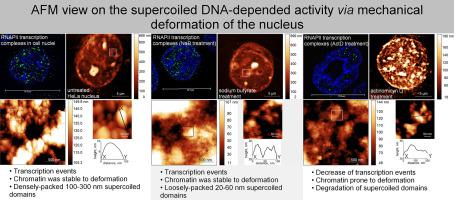Biochimica et Biophysica Acta (BBA) - General Subjects ( IF 3 ) Pub Date : 2024-01-17 , DOI: 10.1016/j.bbagen.2024.130568 V. Yu Bairamukov , R.A. Kovalev , A.V. Ankudinov , R.A. Pantina , N.D. Fedorova , A.S. Bukatin , S.V. Grigoriev , E. Yu Varfolomeeva

|
Background
The gene expression differs in the nuclei of normal and malignant mammalian cells, and transcription is a critical initial step, which defines the difference. The mechanical properties of transcriptionally active chromatin are still poorly understood. Recently we have probed transcriptionally active chromatin of the nuclei subjected to mechanical stress, by Atomic Force Microscopy (AFM) [1]. Nonetheless, a systematic study of the phenomenon is needed.
Methods
Nuclei were deformed and studied by AFM. Non-deformed nuclei were studied by fluorescence confocal microscopy. Their transcriptional activity was studied by RNA electrophoresis.
Results
The malignant nuclei under the study were stable to deformation and assembled of 100–300 nm beads-like units, while normal cell nuclei were prone to deformation. The difference in stability to deformation of the nuclei correlated with DNA supercoiling, and transcription-depended units were responsive to supercoils breakage. The inhibitors of the topoisomerases I and II disrupted supercoiling and made the malignant nucleus prone to deformation. Cell nuclei treatment with histone deacetylase inhibitors (HDACIs) preserved the mechanical stability of deformed malignant nuclei and, at the same time, made it possible to observe chromatin decondensation up to 20–60 nm units. The AFM results were supplemented with confocal microscopy and RNA electrophoresis data.
Conclusions
Self-assembly of transcriptionally active chromatin and its decondensation, driven by DNA supercoiling-dependent rigidity, was visualized by AFM in the mechanically deformed nuclei.
General significance
We demonstrated that supercoiled DNA defines the transcription mechanics, and hypothesized the nuclear mechanics in vivo should depend on the chromatin architecture.
中文翻译:

AFM 揭示转录活性驱动的染色质包装变化
背景
正常和恶性哺乳动物细胞的细胞核中的基因表达不同,转录是关键的初始步骤,它定义了差异。转录活性染色质的机械特性仍然知之甚少。最近,我们通过原子力显微镜 (AFM) 探测了受到机械应力的细胞核的转录活性染色质 [1]。尽管如此,仍需要对这一现象进行系统研究。
方法
原子核变形并通过 AFM 研究。通过荧光共焦显微镜研究未变形的细胞核。通过RNA电泳研究它们的转录活性。
结果
研究中的恶性细胞核能够稳定变形并组装成100-300 nm的珠状单元,而正常细胞核则容易变形。细胞核变形稳定性的差异与 DNA 超螺旋有关,转录依赖性单位对超螺旋断裂有反应。拓扑异构酶 I 和 II 的抑制剂破坏了超螺旋,使恶性细胞核易于变形。用组蛋白脱乙酰酶抑制剂 (HDACIs) 处理细胞核,保留了变形恶性细胞核的机械稳定性,同时,可以观察高达 20-60 nm 单位的染色质解凝聚。AFM 结果辅以共聚焦显微镜和 RNA 电泳数据。
结论
通过 AFM 在机械变形的细胞核中观察到由 DNA 超螺旋依赖性刚性驱动的转录活性染色质的自组装及其解缩。
一般意义
我们证明了超螺旋 DNA 定义了转录机制,并假设体内的核机制应该取决于染色质结构。



























 京公网安备 11010802027423号
京公网安备 11010802027423号